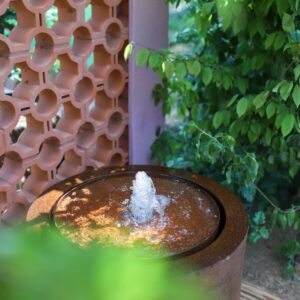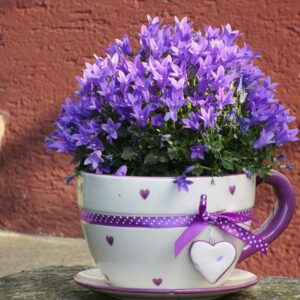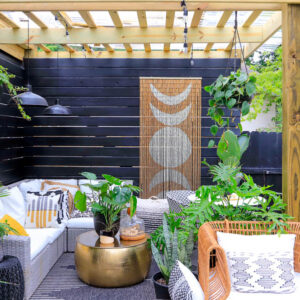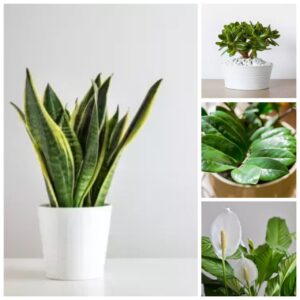There are lots of good reasons to hang plants from your ceiling. Hanging plants is a great way to decorate your home, dressing up some corners that would otherwise go empty. It’s also a clever way to house all the plants you’ve stocked up on. After all, surface space is limited. And once you’ve run out of places to put your plants, hanging some is a must.
The good news? Hanging plants is pretty easy. It’s the kind of project you can knock out in an hour—as long as you have the right plants, planters, and hardware for the job.
To help you figure out how to hang plants from your ceiling, we asked two plant experts to walk us through the process from start to finish.
Meet the Expert
- Melinda Myers is a gardening expert with over 30 years of horticulture experience. She has written more than 20 gardening books, hosts the nationally syndicated gardening program “Melinda’s Garden Moment,” and is a tenured professor with a master’s degree in horticulture.
- Naomi Robinson is a self-proclaimed plant lover and the founder of Houseplant Authority, a website that helps indoor plant owners keep their houseplants happy and healthy.
- Total time: 1 hour
- Working time: 15–30 minutes
- Skill level: Beginner
When to Hang Indoor Plants From the Ceiling
You can hang plants from the ceiling at any time of year. “Any time you have time is a good time to hang a plant,” Melinda Myers, gardening expert, says. But fall and winter are great seasons for the project. Why? When it gets cold out, you’ll have to move your outdoor plants inside—giving you a perfect opportunity to find new homes for all your plants.
But if you need to repot your plants before hanging them, consider hanging them during spring or summer, instead. “It’s good to be aware of the risk of transplant shock,” Naomi Robinson, Houseplant Authority founder, says. “While plants can experience this at any time of the year, they often recover better in their growing period—which is usually spring and summer.”
Tools and Supplies You Will Need
Before getting started, gather the following materials:
- Ladder
- Stud finder
- Pencil
- Drill
- Hanging planter
- Weight-rated hook
How to Hang Indoor Plants From the Ceiling
Step 1: Scout a New Home for Your Plant
Before whipping out your drill and putting hooks in your ceiling, find a place where your plant will thrive. “[Find a] location [that] meets your plant’s light, temperature, and humidity needs,” Robinson says.
And factor hanging height into your assessment. “Those few extra inches of elevation can result in the air being slightly cooler and drier, which may not suit your plant,” Robinson adds.
Step 2: Find a Sturdy Hanging Spot With a Stud Finder
Once you’ve found a suitable new home for your plant, find a sturdy place to install your hook. “Securing the hook into a ceiling joist or stud in the wall provides a secure connection,” Myers says. Use a stud finder to pinpoint a sturdy hanging spot, then lightly mark the location with a pencil.
Step 3: Drill a Small Hole in Your Ceiling
Pair your drill with a drill bit that’s the right size for your hook. (You want the hole to be slightly smaller than your hook.) Then, drill a small hole where you marked your ceiling.
Step 4: Install Your Hook With Care
Double-check that your hook is sturdy enough to support your plant. Consider the weight of your plant and the weight of your planter. “Importantly, you’ll need to consider the extra weight your plant will have when it’s watered and when it grows,” Robinson says.
And make sure your hook is suitable for your installation location. Screw hooks are great for ceiling joists and wall studs. But if you’re drilling into drywall (because you couldn’t find a joist or stud), you’ll need to use a hook with a toggle screw instead.
Step 5: Repot Your Plant and Hang It
If you need to repot your plant, go ahead and do so. Then, attach your hanging plant to your newly installed ceiling hook.
And be sure to check in on your plant periodically. “It can be harder to keep an eye on hanging plants,” Robinson says. So adjust your plant care schedule to ensure your hanging plants are getting as much love as your other ones.
Choose the Right Plant to Hang
You don’t have to be too picky when choosing which plant to hang. “Most plants will be fine in a hanging basket,” Robinson says.
Set yourself up for success by choosing a hardy plant that can withstand the location change and higher elevation. And consider what will look great in your hanging planter. Myers recommends trailing plants—like pothos, spider plants, string of pearls, philodendrons, and various ivies.
Choose the Right Hanging Planter
When picking out a hanging planter, consider two things: weight and drainage.
“Weight is an issue to consider,” Myers says. While clay pots are pretty, they’re heavier than plastic planters. So consider picking a lightweight planter to make things easier on your hook. And no matter what planter you choose, “make sure your hook, rod and hanger can support the weight,” Myers says.
Then, make sure you pick a planter that drains well—and won’t spill water all over your floor. “Not only should the planter have holes, but ensuring it’s got an adequate drainage tray is key,” Robinson says. The drainage tray will catch excess water, keeping your floors from getting soaked every time you water your plants. Just be sure to empty it regularly to avoid root rot.
One final pro tip? Snag a self-watering pot. “Self-watering pots extend the time between watering,” Myers says. That means you can keep your hanging plants in tip-top shape—without climbing onto a ladder to water them every week.
Viewed using Just Read
:strip_icc():format(webp)/hanging-plants-1-black-and-blooms-transform-0d685686cfdf4557abbc9e72271942c1.jpeg)
:strip_icc():format(webp)/hanging-plants-2-jc-design-064b03a944b0486299691ea46f256844.jpeg)
:strip_icc():format(webp)/hanging-plants-3-black-and-blooms-table-for-two-bd57029d1eca4118847bd12291db442b.jpeg)
:strip_icc():format(webp)/hanging-plants-4-afro-bohemian-living-B-7fd361a201c8464ca5cf203b797fa01b.jpeg)
:strip_icc():format(webp)/hanging-plants-5-home-and-spirit-3a9c29e907b04c52b378ab677d23de5d.jpeg)
:strip_icc():format(webp)/hanging-plants-6-black-and-blooms-cozy-bedroom-adb5a348536f47fa8d7a3e320c4e10b6.jpeg)
:strip_icc():format(webp)/hanging-plants-7-black-and-blooms-how-to-style-f4e12a8934b84afe826b0ee5bd76ee31.jpeg)





